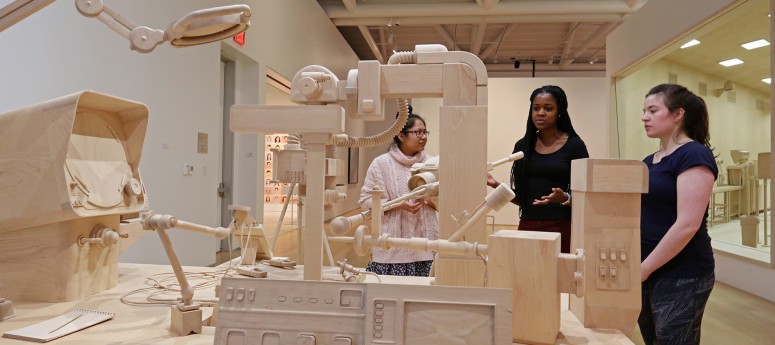Framing Security

From Kenyon News - March 24, 2016
Photo: Alma Urbano-Torres '18, Natasha Siyumbwa '17 and Amelia Barnes '16 examine "Scrutiny," a sculpture by New York artist Roxy Paine on view at the Gund Gallery.
The large diorama of an airport security checkpoint that greets Gund Gallery associate Alma Urbano-Torres ’18 when she enters the gallery’s spring exhibition reflects the world of surveillance in which she was raised.
“We have to feel scared in order to for this to make us feel safe,” said Urbano-Torres, a sociology and modern languages major from Denver.
The diorama, “Checkpoint,” is the work of Roxy Paine, a New York-based artist who has installed his large-scale works in Central Park and Madison Square Park. Paine’s solo show at the Gund Gallery is presented in conjunction with the Center for the Study of American Democracy’s conference April 6-8, titled “The Expectation of Privacy: Encryption, Surveillance and Big Data.”
These issues have shaped the lives of today’s Kenyon students, including Gund Gallery associate Natasha Siyumbwa ’17, a political science major from Lusaka, Zambia. While viewing the Paine exhibit, she noted that she and her peers are accustomed to being scrutinized, whether it’s on social media or in public places. “There are security cameras on us right now,” she said.
Another of the five Paine pieces on display, “Scrutiny,” has a thicket of surveillance devices including a telescope, microphone and video monitors focused on a blank tabletop. That piece captured the attention of Gund Gallery associate Amelia Barnes ’16, an anthropology major with concentrations in environmental studies and public policy from Baltimore. She said “Scrutiny” echoes the discussions she is having in a class on science and society this semester.
“All of these things in this piece are things that we trust to give us the truth,” Barnes said. “But the camera and the telescope here are made of wood. You actually can’t see through them.”
Each of Paine’s five works, on display until May 30, is carved out of light maple and includes fine details resembling everyday objects like power cords, shoelaces and the teeth of a chainsaw. It’s a disquieting effect for these everyday objects, typically made of plastic and stainless steel, to be shown as wooden pieces, said Natalie Marsh, director of the Gund Gallery.
“He’s making some very clear choices. He isn’t painting and otherwise embellishing those meticulously carved maple wood surfaces. That’s quite intentional,” she said. “He wants us to be jarred. He wants us to stop in our tracks and think much more critically about what has come to be commonplace in our society.”
Also notable is what is missing from Paine’s work. No glass separates a gallery visitor from the artwork, so the installation about security is missing a standard piece of gallery security. Plus, the signs in the “Checkpoint” diorama are blank.
“That means you can’t tell what language it is, and with no people to look at to get a sense of who is in this airport, it could be anywhere,” Siyumbwa said.
Urbano-Torres added, “I like that it’s empty. There are no people like you would see in a regular airport. That’s eerie and uncomfortable.”
Paine’s exhibit is paired with another exhibit, “Visibility Machines: Harun Farocki and Trevor Paglen,” to continue the discussion of surveillance with works of photography and video. Paglen makes abstract art out of surveillance photos taken from long distances, and Farocki’s videos are framed discussions of wartime training videos.
These works accompany a film series on the surveillance theme, all leading to the CSAD conference. Marsh said that faculty from the psychology, sociology and political science departments already have tied the exhibits to their classwork.
“It’s so great when people charged with creating programs on this campus can come together and exponentially magnify the dialogue,” Marsh said. “This exhibit shows that international artists are critically questioning the implications of what the FBI director is grappling with in the realm of public policy.”